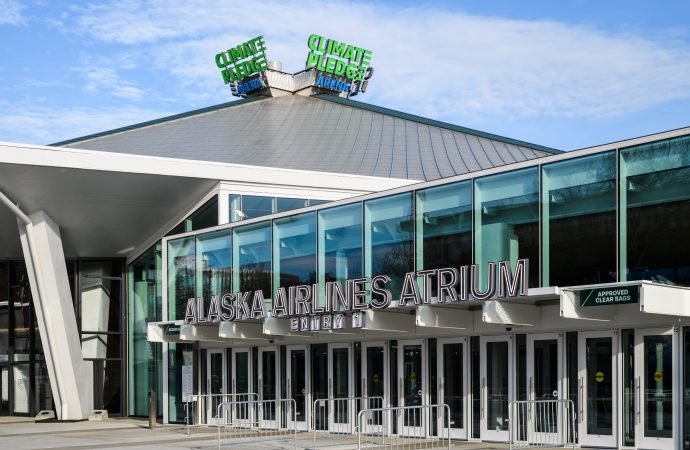The GOAL platform, NHL Venue Metrics and The Toolbox’s ANOC partnership highlight sport’s growing arsenal to make sustainability more accessible, participative and rewarding
“We need to understand what we’re doing and move forward with intent,” said Sofi Armenakian, head of sustainability for the Atlanta Hawks NBA team and its State Farm Arena venue, during a SportTechie Live session focusing on how technology is broadening sustainability efforts in sport.
The common adage, ‘you can’t manage what you can’t measure’, is fundamentally true, but the expectation that sport measures its environmental and social impact – and measures it well – is growing.
Julie Souza, head of sports at AWS Professional Services, added that requests for sustainability data were no longer coming from just one stakeholder group. And while data analytics platforms for sustainability are nothing new, there’s a need in sports for an industry-specific tool that can collect data, decipher it and help sports properties “use it to our advantage”.
Step forward GOAL, the Global Operations and Advanced Leadership platform developed by the Oak View Group (operator of the Climate Pledge Arena in Seattle) alongside Atlanta Hawks and State Farm Arena, Fenway Sports Group and sustainable building expert Jason F. McLennan.
When it comes to sustainability, it’s “hard to know what good looks like in our industry”, said Kristen Fulmer, Oak View Group’s sustainability director. GOAL, according to its creators, will be able to plug that gap as it was “designed by venue operators for venue operators”.
A number of prominent venues and operators dubbed the ‘Founding Circle’, predominantly in the US, will test out that hypothesis after joining the platform at inception. These include: Acrisure Arena (Greater Palm Springs, CA), Budweiser Gardens (London, ON), Citi Field (New York, NY), Climate Pledge Arena (Seattle, WA), Co-op Live (Manchester, UK), Fenway Sports Group (Boston, MA), Footprint Center (Phoenix, AZ), FTX Arena (Miami, FL), Gainbridge Fieldhouse (Indianapolis, IN), Levi’s Stadium (Santa Clara, CA), Moda Center (Portland, OR), Moody Center at University of Texas Austin (Austin, TX), Mullett Arena at Arizona State University (Tempe, AZ), PPG Paints Arena (Pittsburgh, PA), Rocket Mortgage FieldHouse (Cleveland, OH), State Farm Arena (Atlanta, GA), UBS Arena (Belmont Park, NY).
Building upon the foundation of the environmentally sustainable building standard LEED that many of these venues have already obtained, the GOAL platform will help them track their own climate adaptation and mitigation progress during a beta phase. But Fulmer stressed that GOAL was not just a data collection tool, with its primary function being the ability to support performance improvement.
Before users get to the data measurement and tracking element of the tool, they are able to understand and set their context through GOAL’s resources library, which includes case studies of best practices and an index of vetted vendors, as well as options for cross-venue collaboration. Further functionality includes the ability to develop a bespoke ‘roadmap’ with customised tactics for sustainability improvement and the ability to receive third party validation and certification.
“After we have beta tested the platform with our inspiring roster of Founding Circle members, we will invite additional venues to join the movement,” said Fulmer. “We want to right-size the platform to make sure that the data points and thresholds for leadership meet venues anywhere along their sustainability journey, engaging – and without shaming – venues that are just getting started, while also enhancing efforts in venues that already make an impact in a variety of different topics, from waste diversion, to water conservation, to improved indoor air quality.”
In the same week, the National Hockey League (NHL) unveiled a partnership with German multinational SAP on a new “web-based digital platform” that will give the teams in the league the ability to measure and understand their respective carbon footprints.
Called NHL Venue Metrics, the tool will analyse carbon data related to energy, water, waste and recycling. Omar Mitchell, NHL vice-president of sustainability infrastructure and growth initiatives, said that continued measurement and analysis was a “core tenant of our environmental sustainability strategy”, adding that modernising the way the NHL collects sustainability data was a “herculean task”.
As well as collecting data from all 32 teams (who were invited in September to input historical data to create a baseline), NHL Venue Metrics calculates and verifies the data while visualising key numbers through its insights dashboard.
But tools for the advancement of sustainability in sport don’t have to be cloud-based or even focused on data collection. Last week, at its General Assembly in Seoul, the Association of National Olympic Committees (ANOC) presented a new partnership with 11th Hour Racing, a prominent team in The Ocean Race, to use its Toolbox to support the attainment of UNFCCC Sports for Climate Action Framework principles and sustainability goals of the International Olympic Committee’s Olympic Agenda 2020+5.
The Toolbox is a “suite of resources”, including a eight ‘how-to’ guides – focusing on anything from creating a sustainability policy and engaging stakeholders, to assessing progress and reporting – customisable templates and case studies.
“As a key player in the Olympic Movement, the NOCs must take their share of the responsibility to promote positive change, both regarding the protection of our planet but also within human relations,” said Gunilla Lindberg, ANOC general secretary, as she reflected on ANOC’s adoption of The Toolbox. “ANOC will continue to assist the NOCs by sharing best-practice, but also by providing the tools which will facilitate and support NOCs deliver on their sustainability initiatives.”
Damian Foxall, the sustainability manager for the 11th Hour Racing Team, added that ANOC’s adoption of The Toolbox will “help integrate best practices throughout the sporting world”.
As the understanding of the link between a healthy planet and healthy sport grows among decision-makers in the industry, the number of tools and solutions to help them navigate the challenges and opportunities will likely increase. The key is to move forward with intent. Watch this space.
Opt into our weekly newsletter for exclusive content focused on sustainability strategy, communication and leadership for sport’s ecosystem.










Leave a Comment
Your email address will not be published. Required fields are marked with *